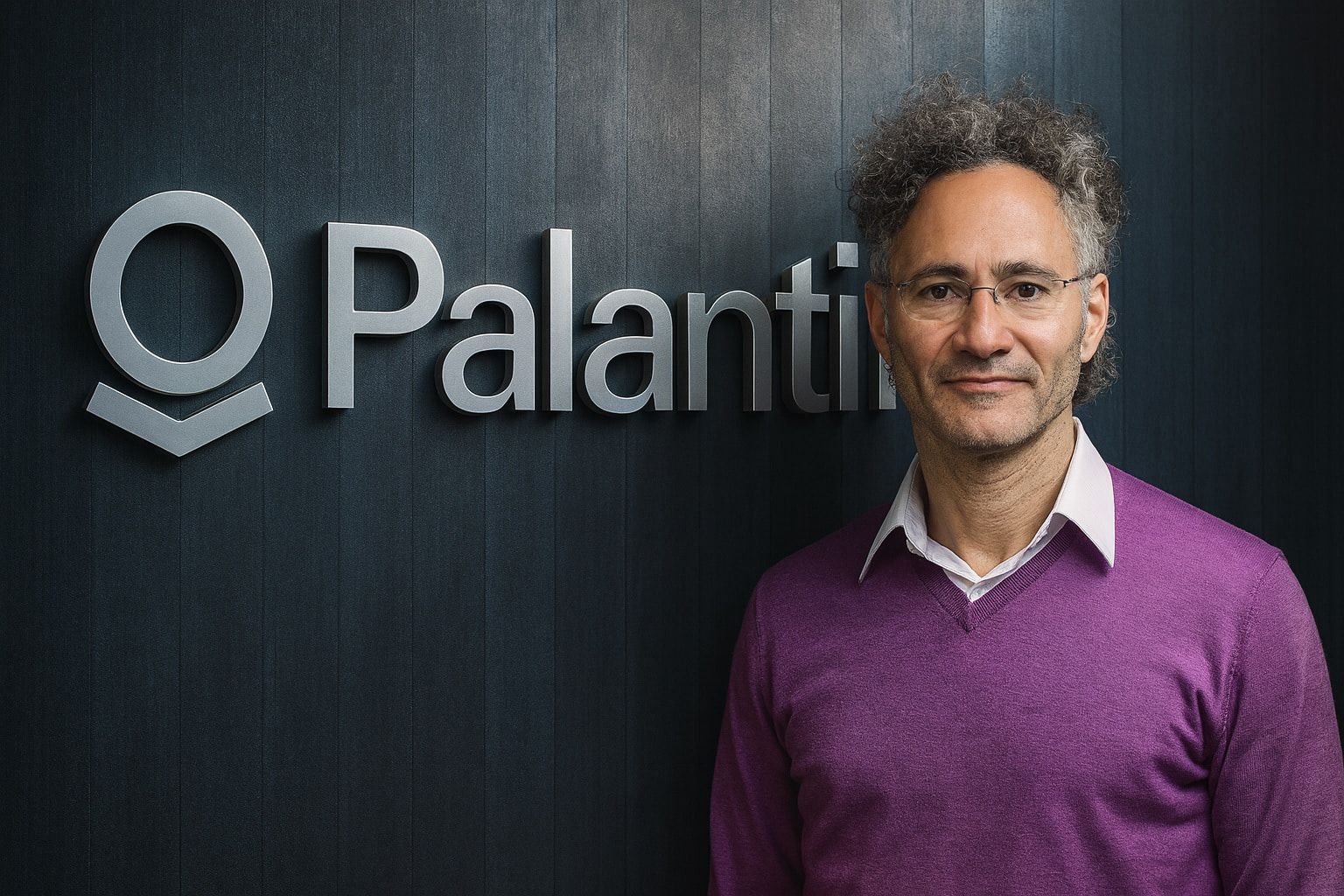- Red-Hot Rally: Palantir Technologies’ stock (NYSE: PLTR) has skyrocketed roughly 300% in 2025, recently hitting an all-time high near $190 per share (around a $400 billion market cap) [1] [2]. It’s one of the S&P 500’s top performers for a second year running, up ~18-fold since its late-2020 IPO [3].
- AI Mega-Deals: A steady drumbeat of big contracts and partnerships is fueling the surge. Palantir won a decade-long $10 billion U.S. Army deal, a £1.5 billion UK defense AI pact, and “game-changing” tie-ups with Boeing, Snowflake, and telecom provider Lumen in recent weeks [4] [5]. These deals underscore booming demand for Palantir’s data analytics and AI platforms across government and industry.
- Blowout Earnings: Palantir’s financials are finally matching the hype. Last quarter’s revenue jumped 48% year-over-year to top $1 billion for the first time (with ~$327 million GAAP profit), and management raised full-year revenue guidance to ~$4.15 billion [6] [7]. Strong federal contracts and accelerating commercial sales (from healthcare to energy) have driven Palantir into solid profitability, boosting investor confidence.
- Analysts Split: Wall Street is sharply divided on PLTR’s outlook. Bulls like Wedbush’s Dan Ives call Palantir “one of the best AI stocks” and even envision a $1 trillion valuation by 2028 [8]. Piper Sandler just hiked its 12-month price target to $201 [9]. But skeptics argue the stock is overvalued: one noted short-seller blasted Palantir’s valuation as “absurd,” pegging fair value closer to $65–$70 [10]. Recent price targets range from under $100 to $215, with a median around $155–$165 (below the current price) and an overall Hold consensus [11] [12].
- Lofty Valuation Risks: At ~100× forward sales and >200× earnings, Palantir trades at one of the most expensive multiples in modern market history [13]. Its ~$426 billion valuation now rivals legacy defense giants [14]. Bulls defend the premium due to Palantir’s growth and “AI arms dealer” role, but any stumble in growth or shift in market sentiment could trigger a sharp pullback [15] [16]. Investors are essentially pricing in perfection, raising bubble concerns if the AI hype fades.
- What’s Next: All eyes are on Palantir’s Q3 earnings report on Nov. 3, 2025, where another strong beat (>$1.08 billion revenue is expected) will be needed to sustain the momentum [17]. Beyond earnings, investors are watching for continued big contract wins, AI product advances, and government deals to justify the stock’s rich valuation. Any new partnerships – or hiccups (like the brief sell-off after an Army memo raised security questions) – could sway the stock [18] [19]. In short, Palantir’s rally is powered by genuine growth and AI optimism, but the stakes are high: execution needs to keep up with sky-high expectations.
Record Rally Powered by AI Hype and Big Deals
Palantir’s stock has been on a tear in late 2025, far outpacing the broader market. As of October 27, PLTR shares were trading around record highs after a week of strong gains. A broad tech rally – driven by cooling inflation and investor excitement over artificial intelligence – helped lift high-growth names like Palantir [20] [21]. On October 24, for example, the Nasdaq surged over 1%, propelling the S&P 500 to fresh all-time highs [22]. Palantir rode that wave, with heavy trading volume as the stock pushed toward the top of its range [23].
Over the past few days, PLTR jumped from the mid-$150s into the $180s, then briefly touched $190+ on Oct. 27 [24]. In fact, the stock hit an all-time high of $190.84 in intraday trading, capping a stunning ~310% gain from a year ago [25]. Such explosive growth has made Palantir a market darling of the AI boom. “Enthusiasm for artificial intelligence extends to data-focused stocks like Palantir,” Reuters noted amid the rally [26]. The company has frequently been mentioned alongside other “AI winners” on CNBC and Bloomberg as investors seek the next big AI play [27]. This buzz has attracted waves of momentum traders, although it also invites volatility. (Notably, when a leaked U.S. Army memo in early October raised alarm about a Palantir-developed battlefield system, PLTR shares slid ~7.5% in a day – only to rebound after the Army and company addressed the concerns [28].)
Why is Palantir skyrocketing? In short, the company is hitting on all cylinders at a time when Wall Street is obsessed with AI. Palantir’s technology is at the intersection of two hot trends – defense and artificial intelligence – giving it a compelling story. This year has brought a “steady drumbeat” of contract announcements across both government and commercial sectors, which “shows Palantir’s tech is in high demand” and underpins the stock’s climb [29]. Every few weeks, another headline hits the tape about Palantir landing a major deal or partnership. This constant positive news flow has kept bulls energized and helped justify the stock’s lofty price – so far.
Major Contracts and Partnerships Fueling Growth
Palantir’s surge has been underwritten by a string of blockbuster deals in 2025, as the company positions itself as an essential provider of AI-powered data platforms. In the government arena, Palantir scored one of its biggest contracts ever with the U.S. Army this summer: a new indefinite-delivery/indefinite-quantity deal valued up to $10 billion over 10 years [30]. This sweeping contract consolidates dozens of Army programs under Palantir’s technology, a clear signal of the Army’s deepening reliance on Palantir’s software. Around the same time, Palantir inked a landmark partnership with the UK Ministry of Defence, which pledged up to £1.5 billion (~$1.8 billion) to deploy Palantir’s AI platforms across British defense operations [31]. The UK even agreed to establish Palantir’s European defense HQ in London as part of the deal, and Palantir secured its largest-ever UK contract (~£750 million) for military software [32]. British officials hailed it as “a major vote of confidence” in Palantir’s tech [33]. These government deals not only bring in substantial revenue; they also serve as high-profile endorsements of Palantir’s capabilities on the world stage.
On the commercial side, Palantir is rapidly expanding its footprint via alliances in various industries. In late September, Boeing’s defense and aerospace unit announced it will integrate Palantir’s AI-driven platform across its operations, calling the move “game-changing” for speeding up data-driven decisions from “weeks… to days and hours” [34] [35]. That news gave PLTR a quick stock boost and hinted at Palantir’s widening role beyond software – essentially embedding into the supply chains of manufacturing and defense giants. Palantir also pushed into the energy sector by agreeing to develop a $100 million “AI nuclear operating system” for a next-gen power project [36], underscoring its versatility in high-tech infrastructure.
In just the past few weeks, new partnerships have targeted enterprise AI applications. On Oct. 16, Palantir and cloud data firm Snowflake unveiled a strategic partnership to connect Snowflake’s AI Data Cloud with Palantir’s Foundry and Artificial Intelligence Platform (AIP) [37]. This integration aims to “streamline enterprise AI pipelines” for joint customers, and it was well-received – Snowflake’s stock jumped on the announcement [38]. A week later, telecom provider Lumen Technologies struck a multi-year deal with Palantir to help companies deploy AI at scale. Lumen will reportedly spend over $200 million on Palantir’s software as it combines Palantir’s Foundry/AIP with Lumen’s high-performance fiber networks [39] [40]. The goal is to bridge advanced AI analytics with the connectivity needed for real-time enterprise use – essentially bringing Palantir’s AI insights closer to where data flows. And in the healthcare field, Palantir is making inroads with its new Artificial Intelligence Platform. One example: OneMedNet, a medical data firm, chose Palantir’s AIP to power a next-gen clinical analytics network. “Palantir’s AIP helps us revolutionize our ability to deliver high-quality, regulatory-compliant data at remarkable speed,” OneMedNet’s CEO said, touting breakthroughs in AI-driven research using Palantir’s tech [41]. This multi-year project taps into an $868 billion healthcare AI market, illustrating the vast opportunities as Palantir extends beyond its defense roots [42].
All these wins – from defense contracts to industry partnerships – paint a picture of a company at the epicenter of the AI adoption wave. Palantir’s software platforms (like Gotham for government intelligence and Foundry for enterprise data) are becoming embedded in critical operations across sectors. Each deal also tends to generate follow-on business (and headlines) as clients expand their use of Palantir’s tools. For investors, these announcements have provided tangible evidence that Palantir is monetizing the AI boom, not just talking about it. As TechStock² analysts put it, the “steady drumbeat” of new contracts has kept bullish sentiment strong [43]. However, Palantir’s close ties to government work can cut both ways – negative developments can spark volatility. Case in point: when that internal Army memo in early October flagged security “high risks” in a battlefield system co-developed by Palantir, it briefly rattled investors [44]. (The Army quickly clarified the issues were in a prototype and “had been addressed… normal testing process,” and Palantir noted no vulnerabilities in its platform [45]. The stock bounced back after these reassurances.) This episode shows that while Palantir’s pipeline of deals is propelling the stock, vigilance is key – any sign of trouble in a major project can spur knee-jerk selloffs, though so far dips have been quickly bought.
Financial Momentum and AI Edge vs. Valuation Worries
Underpinning Palantir’s market rise is a story of improving financial performance. For years after its IPO, Palantir was criticized for heavy losses and stock-based compensation. But 2023 marked a turning point – Palantir turned profitable, and 2025 has solidified that trend [46]. In its second quarter of 2025 (reported in August), Palantir delivered blowout numbers: revenue of about $1.03 billion (up 48% year-on-year), GAAP net income of $327 million (up 144%), and free cash flow well into the black [47] [48]. It was the company’s first billion-dollar quarter, a milestone that validated Palantir’s long-term investments in product development and customer acquisition. Off the strong Q2 results, management raised its full-year revenue forecast to ~$4.14–$4.15 billion, implying ~45% growth for 2025 [49]. In other words, Palantir’s growth is accelerating even at a large scale – a rare feat. The company’s “Rule of 40” score (growth + profit margin) is now well above industry averages [50], and its operating margins are improving as big government contracts ramp up. Palantir’s CEO Alex Karp struck an optimistic tone on the earnings call, saying the company is “very, very bullish on America” – pointing to robust federal tech spending – and highlighting strong demand in both defense and commercial arenas [51].
These fundamental gains give bulls a solid fundamental narrative: Palantir isn’t just riding hype, it’s delivering real earnings and cash flow. The firm’s unique AI-powered software and two-decade head start in big data analytics provide a competitive moat. Industry analysts rank Palantir as a leader in “decision intelligence” platforms and enterprise AI/ML software [52]. Essentially, Palantir’s platforms excel at integrating vast, disparate datasets – a crucial advantage as organizations seek to harness AI. Palantir’s role as an “AI arms dealer” to both militaries and corporations means it profits from the AI revolution without being tied to any single application [53]. This broad relevance (from battlefield intelligence to hospital data to supply-chain optimization) is a key reason investors have piled in.
Yet, for all the positives, even many bulls acknowledge the stock’s valuation looks stretched. Palantir’s market capitalization now flirts with the $400 billion mark, putting it in league with or above older tech-defense players like Lockheed Martin or Raytheon [54]. However, Palantir’s sales are only a few billion dollars a year – tiny compared to those giants – which yields eye-popping multiples. By one estimate, PLTR trades at nearly 90× its forecast 2025 revenues, making it “one of the most expensive” stocks of its size in recent history [55]. For context, even high-flying NVIDIA (a poster child of the AI boom) trades around 20× sales, and the average S&P 500 stock is under 5×. “Investors remain bullish for now… but such lofty metrics also raise bubble concerns,” one Reuters analysis warned [56]. In fact, in September Reuters Breakingviews dubbed Palantir’s valuation “hyper-prime” – noting the company is valued almost as richly as the entire Big-3 defense contractors combined, despite only ~$4 billion in annual revenue [57] [58]. The same piece pointed out that Palantir’s forward price-to-sales multiple (110×+) dwarfs anything seen even during past tech bubbles, aside from a few dot-com era outliers [59].
This disconnect between sky-high stock price and still-modest revenue base is the crux of the bull-bear debate. Bulls argue that Palantir’s steep valuation will be justified by years of 30–50% growth ahead as AI adoption explodes. They see Palantir as a unique platform company that could potentially grab a significant slice of a trillion-dollar AI software market in the coming decade [60]. Some optimists even forecast Palantir’s sales could hit $40–50 billion by 2030 if it continues to land major deals – implying the company is only in the early innings of its growth curve [61] [62]. From that perspective, Palantir’s current $400B market cap might not be crazy if you believe it’s on track to become one of the world’s software titans (indeed, some analysts think Palantir could rival Oracle’s size by 2030 if all goes well [63]). But bears counter that those rosy scenarios bake in near-flawless execution and a sustained AI investment boom. Any slowdown – say, growth decelerating below expectations, or government budgets tightening – could cause the stock to “re-rate” sharply downward. With a valuation this rich, even slight disappointments can have an outsized impact.
Thus far in 2025, Palantir has executed very well and the macro environment (ample government spending, strong tech investment, investor risk appetite) has been favorable. But moving forward, investors will need to see continuous evidence of stellar growth to remain comfortable paying such premiums. As one market strategist noted, the stock’s momentum is supported by a broad trend of companies crushing earnings forecasts this year – which “justifies the rally” in high-growth names [64]. If Palantir keeps beating estimates and raising guidance, bulls believe the stock can maintain its upward trajectory (with occasional pullbacks). However, any signs of faltering – a missed quarterly target, a contract loss, or even a sector rotation away from tech – could bring a swift reality check to Palantir’s valuation. In sum, the company’s fundamentals are much stronger than a year ago, but so is its stock price; the bar is set high.
Bulls vs. Bears: What the Analysts Say
The debate around Palantir’s future has only intensified with its recent surge. Wall Street analysts are notably split on how much upside (if any) is left. On one end, die-hard bulls see Palantir becoming an enduring powerhouse of the AI age. Wedbush Securities’ tech guru Dan Ives has repeatedly pounded the table on PLTR, calling it “one of the best AI stocks investors can own.” He argues the AI-driven digital transformation across industries is still in the early stages – likening the current moment to an “all-night party” that’s only at “10:00 p.m.” (with plenty of festivities ahead) [65]. Ives and a few others foresee Palantir leveraging its first-mover advantage in AI software to potentially triple its value again within a few years [66]. In fact, after Q2’s results, Piper Sandler boosted its 12-month price target to $201 [67] – which would be a record high – citing Palantir’s robust pipeline and “over $7 billion” in already contracted revenue backlog [68]. Bank of America’s bull-case scenario is as high as $215 [69]. These optimists point to Palantir’s unrivaled position at the nexus of AI and big data: few, if any, competitors offer the same proven solutions for mission-critical, secure data integration at massive scale. As long as AI adoption in government and Fortune 500 companies keeps accelerating, bulls say Palantir’s growth story is “only getting started.”
On the other side, skeptics see a classic case of irrational exuberance. Noted short-seller Andrew Left of Citron Research has publicly slammed Palantir’s valuation, calling the stock’s climb “absurd” and arguing that based on a more reasonable software multiple, “the company’s true value should be only ~$65–$70 per share” [70]. That’s less than half of the current price – effectively a prediction that the hype will eventually fizzle. Several Wall Street firms that admire Palantir’s technology have nonetheless downgraded the stock simply because of its price. For instance, UBS and Cantor Fitzgerald have Neutral ratings despite the AI excitement, with price targets of $165 and $155 respectively [71]. These analysts worry that even if Palantir continues to grow fast, the stock’s valuation already reflects years of future expansion. They note Palantir now trades at a hefty premium to even other AI software peers (like C3.ai or enterprise cloud companies), which could limit further upside. In their view, the risk/reward has become less favorable – Palantir might be a great company, but at $180+ a share, much of the good news could be priced in.
The current consensus rating for Palantir’s stock is effectively “Hold” [72]. Price forecasts for the next 12 months span a very wide range (roughly $100 to $215 among reputable analysts), underscoring the uncertainty [73]. The median target in the mid-$150s implies modest downside from recent levels [74]. Of course, these targets can and do shift with the news flow – we’ve seen some analysts play catch-up and raise targets as the stock marched higher. But the broad takeaway is clear: optimism about Palantir’s business is tempered by concern about its stock price. As one analyst quipped, “great company, expensive stock” is a common refrain. There’s also debate about how sustainable Palantir’s growth is: Bulls believe the AI revolution and mounting defense needs will provide a long runway, whereas bears question if growth can stay near 40–50% for much longer once initial contract spurts normalize.
Outlook: Key Things to Watch
Going forward, the next major catalyst on the calendar is Palantir’s third-quarter earnings, set for November 3, 2025 [75]. After two consecutive blowout quarters (Q1 and Q2 of 2025 both beat expectations and saw guidance raised), pressure is on for Palantir to deliver another strong report. Investors will be laser-focused on whether the company’s revenue keeps growing at 40%+ and if margins expand, as this would reinforce the bullish narrative. Management’s commentary will also be closely parsed for updates on new contracts and the pipeline – especially any big wins in areas like international defense or large commercial clients. Expectations are running high: Palantir’s own guidance implies Q3 revenue above $1.08 billion [76], so anything short of that could disappoint. Conversely, if Palantir beats again or hikes its full-year outlook further, it could propel the stock to new highs (beyond the ~$190 mark).
Apart from earnings, there are several broader factors investors should watch. First, keep an eye on the pace of contract announcements. Palantir’s rally has been news-driven, so continued momentum in deal flow is important. Any major new government awards (for example, a rumored Pentagon program or additional NATO contracts) would reinforce growth estimates and could be catalysts for the stock. Likewise, new commercial partnerships in high-profile industries (finance, healthcare, cloud computing, etc.) tend to generate excitement – much like the Snowflake and Lumen deals did [77] [78]. These not only add revenue but also validate Palantir’s usefulness in diverse contexts.
On the flip side, investors should be wary of any signs that the AI spending boom might slow. Palantir’s fortunes are now tightly linked to enterprise and government AI budgets. If macroeconomic conditions or political shifts lead to tightening in IT spending (or if interest rates rise further, making growth stocks less attractive), that could cool the fever around AI plays like PLTR. Also, as Palantir’s backlog of big projects grows, execution becomes key – the company will need to deliver on complex implementations. Any high-profile project setbacks or unhappy customers (especially in sensitive government work) could dampen the stock’s momentum. The brief scare with the Army program in early October is a reminder: Palantir’s close ties to defense mean even perceived issues can spark volatility [79].
Another item to watch is insider activity and leadership signals. CEO Alex Karp and co-founder Peter Thiel have periodically sold shares in the past; any large insider sale could be read as a signal that management views the stock as fully valued. Conversely, if Palantir initiates a stock split or some shareholder-friendly move, that could indicate confidence in future upside. There’s also speculation about whether Palantir might start paying a dividend or share buybacks down the road (as free cash flow rises), though for now the company seems more focused on reinvesting in growth.
In terms of medium-term forecasts, the divergence among experts is stark. Some see Palantir continuing to compound gains if it keeps capitalizing on AI trends – for instance, envisioning the stock in the $250+ range in a year or two under a best-case scenario. A notable bullish scenario from Wedbush projects Palantir could approach a trillion-dollar valuation (~$500 per share) by 2028 if it maintains its trajectory [80]. On the other hand, more cautious forecasts suggest the stock could stall or even pull back to more rational multiples. A number of analysts wouldn’t be surprised to see PLTR trading closer to $120–$150 next year (down 20–35%) if the market rotates away from high-fliers or if Palantir’s growth slows to a more “normal” tech rate [81]. In short, the range of outcomes is wide – befitting a high-growth, high-valuation stock in a fast-evolving sector.
For now, Palantir remains a market phenomenon: a company benefiting from powerful thematic trends (AI, big data, defense modernization) and delivering strong results, yet also carrying a valuation that assumes near-flawless execution. The stock’s recent performance suggests that investors believe Palantir will continue to ride the AI wave and dominate its niche. As long as the contracts keep coming and the earnings keep rising, that belief can become a self-fulfilling prophecy. But if the narrative slips – even briefly – the correction could be swift, as high-flyers have little margin for error.
Bottom Line: Palantir’s 2025 run-up has been extraordinary, turning the once-secretive data firm into a nearly $400 billion heavyweight. The combination of surging AI demand, big-ticket deals, and improving financials has created a perfect storm for the stock’s rise [82] [83]. Yet, with great gains come great expectations. Investors should revel in Palantir’s success but also remain alert. The next chapters – starting with the upcoming earnings and continuing through new AI deployments – will determine if PLTR’s rally is sustainable or if this rocketship needs to refuel. In the meantime, Palantir has undeniably become one of 2025’s most watched – and debated – stocks, embodying both the promise and the peril of the AI boom.
Sources: Financial news and analysis from TechStock² (ts2.tech) [84] [85]; Reuters news reports [86] [87]; Investing.com [88]; company statements. All information is current as of October 27, 2025.
References
1. ts2.tech, 2. www.investing.com, 3. ts2.tech, 4. ts2.tech, 5. www.reuters.com, 6. ts2.tech, 7. ts2.tech, 8. ts2.tech, 9. ts2.tech, 10. ts2.tech, 11. ts2.tech, 12. ts2.tech, 13. www.reuters.com, 14. ts2.tech, 15. ts2.tech, 16. ts2.tech, 17. ts2.tech, 18. ts2.tech, 19. ts2.tech, 20. ts2.tech, 21. ts2.tech, 22. ts2.tech, 23. ts2.tech, 24. www.investing.com, 25. www.investing.com, 26. ts2.tech, 27. ts2.tech, 28. ts2.tech, 29. ts2.tech, 30. ts2.tech, 31. ts2.tech, 32. ts2.tech, 33. ts2.tech, 34. ts2.tech, 35. ts2.tech, 36. ts2.tech, 37. ts2.tech, 38. ts2.tech, 39. www.reuters.com, 40. www.reuters.com, 41. ts2.tech, 42. ts2.tech, 43. ts2.tech, 44. ts2.tech, 45. ts2.tech, 46. ts2.tech, 47. ts2.tech, 48. ts2.tech, 49. ts2.tech, 50. ts2.tech, 51. ts2.tech, 52. ts2.tech, 53. ts2.tech, 54. ts2.tech, 55. www.reuters.com, 56. ts2.tech, 57. www.reuters.com, 58. www.reuters.com, 59. www.reuters.com, 60. www.reuters.com, 61. www.reuters.com, 62. www.reuters.com, 63. ts2.tech, 64. ts2.tech, 65. ts2.tech, 66. ts2.tech, 67. ts2.tech, 68. www.investing.com, 69. ts2.tech, 70. ts2.tech, 71. ts2.tech, 72. ts2.tech, 73. ts2.tech, 74. ts2.tech, 75. ts2.tech, 76. ts2.tech, 77. ts2.tech, 78. www.reuters.com, 79. ts2.tech, 80. ts2.tech, 81. ts2.tech, 82. ts2.tech, 83. ts2.tech, 84. ts2.tech, 85. ts2.tech, 86. www.reuters.com, 87. ts2.tech, 88. www.investing.com







